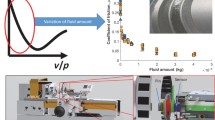Abstract
We used a single-asperity microscopic tribosystem diamond sphere/Cu sheet to investigate the relevant phenomena affecting the dynamics of friction and wear in a macroscopic system. The influence of the average grain size of the softer of two tribopartners on friction and wear was investigated in particular. The observed tribosystem experienced a natural transition during the running time, from severe plastic flow to predominating boundary lubrication. This fact was used to study the influence of poly-α-olefine base oil and fully formulated engine oil Fuchs Titan SAE 5W45 on friction and wear during severe deformation and the boundary lubrication regime. It is shown that the initial grain size has a crucial influence on wear and friction only during first sliding interactions. During the initial sliding, the grain size rapidly decreases due to plastic deformation. The grains then become uniformly equal in size in every initial situation after approximately 30 cycles. Initially larger grains result in increased friction and wear as well as higher sensitivity to the kind of lubrication.











Similar content being viewed by others
References
Kragelsky, I., Dobychin, M., Kombalov, V.: Friction and Wear, Calculation Methods. Pergamon Press, Oxford (1982)
Bowden, F., Tabor, D.: The Friction and Lubrication of Solids. Clarendon Press, Oxford (1950)
Blau, P.J.: Friction and Wear Transitions of Materials. Noyes Publications, Park Ridge (1989)
Kehrwald, B.: Untersuchung der Vorgänge in tribologischen Systemen während des Einlaufs. PhD thesis, University Karlsruhe (1998)
Blau, P.: Friction Science and Technology. Marcel Dekker, Amsterdam (1996)
Rigney, D.A., Hirth, J.P.: Plastic deformation and sliding friction of metals. Wear 53, 345–370 (1979)
Kuhlmann-Wilsdorf, D., Ives, L.K.: Subsurface hardening in erosion-damaged copper as inferred from the dislocation cell structure, and its dependence on particle velocity and angle of impact. Wear 85, 361–373 (1983)
Young, J.L. Jr., Kuhlmann-Wilsdorf, D., Hull, R.: The generation of mechanically mixed layers (MMLs) during sliding contact and the effects of lubricant thereon. Wear 246, 74–90 (2000)
Bednar, M.S., Kuhlmann-Wilsdorf, D.: Amorphous and alloy film formation in sliding of silver on copper. Wear 181–183, 922–937 (1995)
Blau, P.: Investigation of the nature of micro-indentation hardness gradients below sliding contacts in five copper alloys worn against 52100 steel. J. Mater. Sci. 19, 1957–1968 (1984)
Rice, S.L., Nowotny, H., Wayne, S.F.: Characteristics of metallic subsurface zones in sliding and impact wear. Wear 74, 131–142 (1981)
Rigney, D.A., Divakar, R., Kuo, S.M.: Deformation substructures associated with very large plastic strains. Scripta Metall. Mater. 27, 975–980 (1992)
Shakhvorostov, D., Gleising, B., Büscherb, R., Dudzinski, W., Fischer, A., Scherge, M.: Microstructure of tribologically induced nanolayers produced at ultra-low wear rates. Wear 263, 1259–1265 (2007)
Schiøtz, J., Di Tolla, F., Jacobsen, K.: Softening of nanocrystalline metals at very small grain sizes. Nature 391, 561–563 (1998)
Arzt, E.: Size effects in materials due to microstructural and dimensional constrains: a comparative review. Acta Mater 46, 5611–5626 (1998)
Shakhvorostov, D., Pöhlmann, K., Scherge, M.: Structure and mechanical properties of tribologically induced nanolayers. Wear 260, 433–437 (2006)
Ohmae, N., Tsukizoe, T., Akiyama, F.: On the microscopic processes involved in metallic friction. Philos. Mag. A 40, 803–810 (1979)
El-Raghy, T., Blau, P., Barsoum, M.: Effect of grain size on friction and wear behavior of Ti3SiC2. Wear 238, 125–130 (2000)
Bregliozzi, G., Di Schino, A., Kenny, H., J.M. Haefke: Influence of atmospheric humidity and grain size on the friction and wear of high nitrogen austenitic stainless steel. J. Mater. Sci. 39, 1481–1484 (2004)
Scherge, M., Gorb, S.N.: Biological Micro- and Nanotribology. Nature’s Solutions. Springer, Berlin (2001)
Kayaba, T., Hokkirigawa, K., Kato, K.: Analysis of the abrasive wear mechanism by successive observations of wear processes in a scanning electron microscope. Wear 110, 419–430 (1986)
Zum Gahr, K.: Microstructure and wear of materials. Elsevier, Amsterdam (1987)
Czanderna, A.: Methods of surface analysis, Vol. 1. Elsevier, Amsterdam (1975)
Watson, D.: Improved dynamic range and automated lineshape differentiation in AES/XPS composition versus depth profiles. Surf. Interface Anal. 15, 516–524 (1990)
De Barros, M.I., Bouchet, J., Raoult, I., Le Mogne, T., Martin, J.M., Kasrai, M., Yamada, Y.: Friction reduction by metal sulfides in boundary lubrication studied by XPS and XANES analyses. Wear 254, 863–870 (2003)
Mosey, N.J., Müser, M.H., Woo, T.K.: Molecular mechanisms for the functionality of lubricant additives. Science 307, 1612–1615 (2005)
Rigney, D.A.: Transfer, mixing and associated chemical and mechanical processes during the sliding of ductile materials. Wear 245, 1–9 (2000)
Heinicke, G.: Tribochemistry. Hanser Verlag, München (1984)
Hall, E.O.: The deformation of mild steel. III. Discussion of results. Proc. Phys. Soc. B 64, 747–753 (1951)
Petch, N.J.: The cleavage strength of polycrystals. J. Iron Steel Inst. 174, 25–28 (1953)
Acknowledgments
The authors are grateful to T. Ditz from the Institut für Materialforschung IMF II, Forschungszentrum Karlsruhe GmbH, for the measurement of hardness and Young’s modulus profiles of Cu samples. We also thank L. Echtle for help in preparing the Cu samples, and acknowledge M. H. Müser for very helpful discussion.
Author information
Authors and Affiliations
Corresponding author
Rights and permissions
About this article
Cite this article
Shakhvorostov, D., Jian, L., Nold, E. et al. Influence of Cu Grain Size on Running-in Related Phenomena. Tribol Lett 28, 307–318 (2007). https://doi.org/10.1007/s11249-007-9274-1
Received:
Accepted:
Published:
Issue Date:
DOI: https://doi.org/10.1007/s11249-007-9274-1




